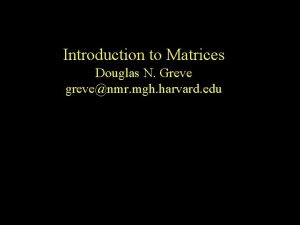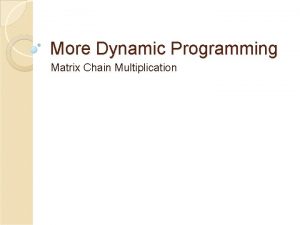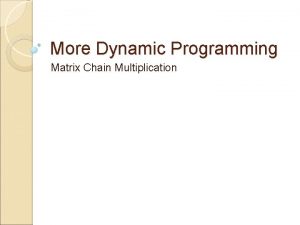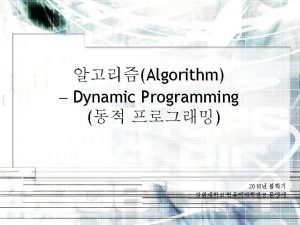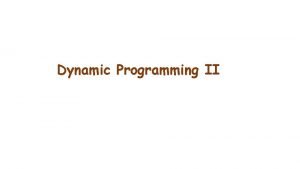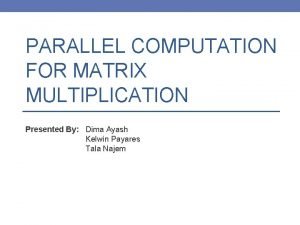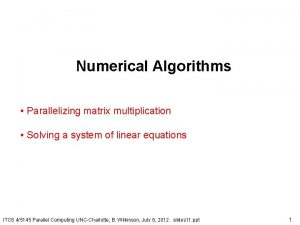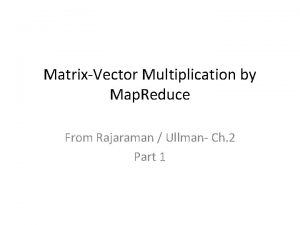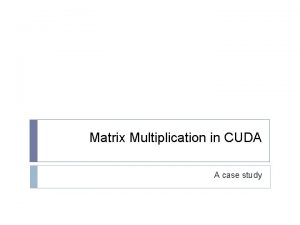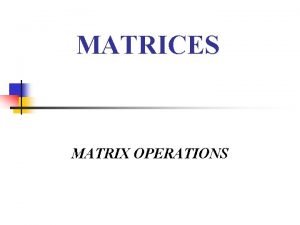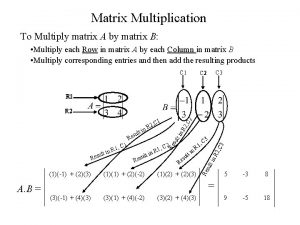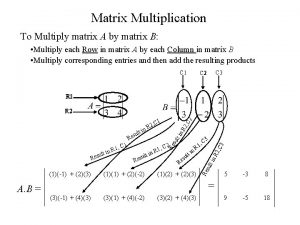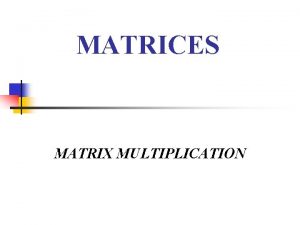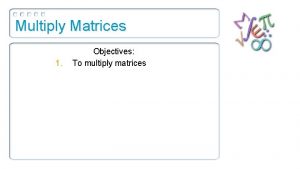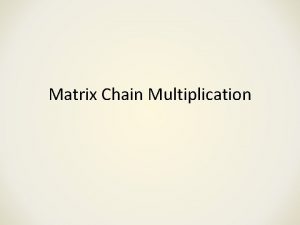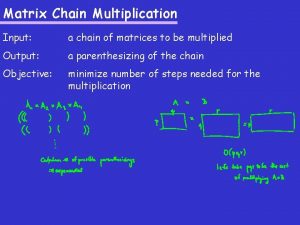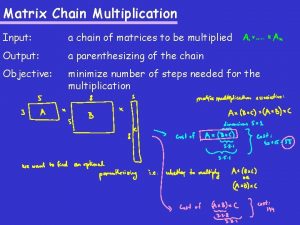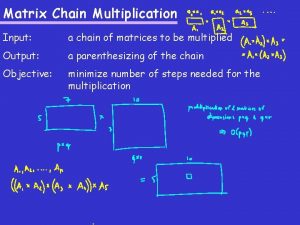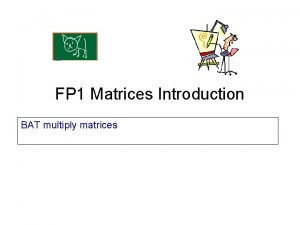Matrix Chain Multiplication Given some matrices to multiply













- Slides: 13

Matrix Chain Multiplication • Given some matrices to multiply, determine the best order to multiply them so you minimize the number of single element multiplications. – i. e. Determine the way the matrices are parenthesized. • First off, it should be noted that matrix multiplication is associative, but not commutative. But since it is associative, we always have: • ((AB)(CD)) = (A(B(CD))), or any other grouping as long as the matrices are in the same consecutive order. • BUT NOT: ((AB)(CD)) = ((BA)(DC))

Matrix Chain Multiplication • It may appear that the amount of work done won’t change if you change the parenthesization of the expression, but we can prove that is not the case! • Let us use the following example: – Let A be a 2 x 10 matrix – Let B be a 10 x 50 matrix – Let C be a 50 x 20 matrix • But FIRST, let’s review some matrix multiplication rules…

Matrix Chain Multiplication • Let’s get back to our example: We will show that the way we group matrices when multiplying A, B, C matters: – Let A be a 2 x 10 matrix – Let B be a 10 x 50 matrix – Let C be a 50 x 20 matrix • Consider computing A(BC): – # multiplications for (BC) = 10 x 50 x 20 = 10000, creating a 10 x 20 answer matrix – # multiplications for A(BC) = 2 x 10 x 20 = 400 – Total multiplications = 10000 + 400 = 10400. • Consider computing (AB)C: – # multiplications for (AB) = 2 x 10 x 50 = 1000, creating a 2 x 50 answer matrix – # multiplications for (AB)C = 2 x 50 x 20 = 2000, – Total multiplications = 1000 + 2000 = 3000

Matrix Chain Multiplication • Thus, our goal today is: • Given a chain of matrices to multiply, determine the fewest number of multiplications necessary to compute the product.

Matrix Chain Multiplication • Formal Definition of the problem: – Let A = A 1 A 2 . . . An – Let Mi, j denote the minimal number of multiplications necessary to find the product: • Ai Ai+1 . . . Aj. – And let pi-1 xpi denote the dimensions of matrix Ai. • We must attempt to determine the minimal number of multiplications necessary(m 1, n) to find A, – assuming that we simply do each single matrix multiplication in the standard method.

Matrix Chain Multiplication • The key to solving this problem is noticing the sub -problem optimality condition: – If a particular parenthesization of the whole product is optimal, then any sub-parenthesization in that product is optimal as well. • Say What? – If (A (B ((CD) (EF)) ) ) is optimal – Then (B ((CD) (EF)) ) is optimal as well – Proof on the next slide…

Matrix Chain Multiplication • Assume that we are calculating ABCDEF and that the following parenthesization is optimal: • (A (B ((CD) (EF)) ) ) – Then it is necessarily the case that • (B ((CD) (EF)) ) – is the optimal parenthesization of BCDEF. • Why is this? – Because if it wasn't, and say ( ((BC) (DE)) F) was better, then it would also follow that • (A ( ((BC) (DE)) F) ) was better than • (A (B ((CD) (EF)) ) ),

Matrix Chain Multiplication • Our final multiplication will ALWAYS be of the form – (A 1 A 2 . . . Ak) (Ak+1 Ak+2 . . . An) • In essence, there is exactly one value of k for which we should "split" our work into two separate cases so that we get an optimal result. – – – – Here is a list of the cases to choose from: (A 1) (A 2 A 3 . . . An) (A 1 A 2) (A 3 A 4 . . . An) (A 1 A 2 A 3) (A 4 A 5 . . . An). . . (A 1 A 2 . . . An-2) (An-1 An) (A 1 A 2 . . . An-1) (An) • Basically, count the number of multiplications in each of these choices and pick the minimum. – One other point to notice is that you have to account for the minimum number of multiplications in each of the two products.

Matrix Chain Multiplication • Consider the case multiplying these 4 matrices: – – A: 2 x 4 B: 4 x 2 C: 2 x 3 D: 3 x 1 • 1. (A)(BCD) - This is a 2 x 4 multiplied by a 4 x 1, – so 2 x 4 x 1 = 8 multiplications, plus whatever work it will take to multiply (BCD). • 2. (AB)(CD) - This is a 2 x 2 multiplied by a 2 x 1, – so 2 x 2 x 1 = 4 multiplications, plus whatever work it will take to multiply (AB) and (CD). • 3. (ABC)(D) - This is a 2 x 3 multiplied by a 3 x 1, – so 2 x 3 x 1 = 6 multiplications, plus whatever work it will take to multiply (ABC).

This leads us to the following recursive formula: Matrix Chain Multiplication • Our recursive formula: – Mi, j = min value of Mi, k + Mk+1, j + pi-1 pkpj, over all valid values of k. • Now let’s turn this recursive formula into a dynamic programming solution – Which sub-problems are necessary to solve first? – Clearly it's necessary to solve the smaller problems before the larger ones. • In particular, we need to know mi, i+1, the number of multiplications to multiply any adjacent pair of matrices before we move onto larger tasks. • Similarly, the next task we want to solve is finding all the values of the form mi, i+2, then mi, i+3, etc.

Matrix Chain Multiplication • Basically, we’re checking different places to “split” our matrices by checking different values of k and seeing if they improve our current minimum value.


 Matrix multiplication dimensions
Matrix multiplication dimensions Matrix chain multiplication definition
Matrix chain multiplication definition Matrix chain multiplication example
Matrix chain multiplication example Matrix chain multiplication 알고리즘
Matrix chain multiplication 알고리즘 Matrix
Matrix Matrix transpose times matrix
Matrix transpose times matrix Grazing food chain diagram
Grazing food chain diagram Fox algorithm matrix multiplication
Fox algorithm matrix multiplication Matrix multiplication time complexity
Matrix multiplication time complexity Matrix vector multiplication by mapreduce
Matrix vector multiplication by mapreduce Hadoop matrix multiplication
Hadoop matrix multiplication Cuda matrix multiplication
Cuda matrix multiplication Stan gpu
Stan gpu Matrices
Matrices
